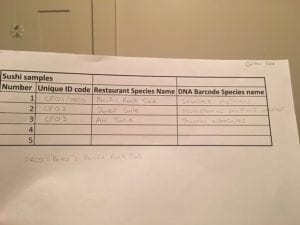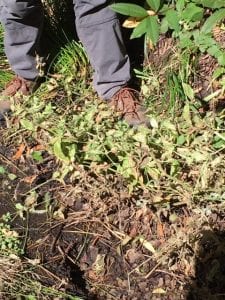Carter Pope
Professor John Paul
Molecular Ecology
10/28/18
Lab 9 Entry
PCR Reactions for Plant DNA
On October 24th, I arrived at the lab and continued with my focus on the plant DNA. My lab group and I began by obtaining our test tubes of our three samples of different plant genomic DNA and went to the corner to begin the gel electrophoresis. Kayla and Jinwoo used a micropipette to transfer 1 microliter of loading dye and 3 microliters of each person’s personal sample of DNA onto a piece of parafilm in order to make a total of 12 little 4 microliter droplets. These droplets were recorded on a separate piece of paper for later identification purposes and then the droplets were transferred into separate wells inside the gel. Once everyone had their droplets in the wells, the gel was then run for about 20 minutes at around 140 volts. Once these gels were completed, they were taken to the back machine to be analyzed by our professor.
Thought: I couldn’t find the picture of my gel on canvas, but I know that one of Kayla’s samples and one of Jinwoo’s samples didn’t work as well so we removed those from our batch, along with a few other samples that didn’t work from other groups at the lab. Peter and I were fortunate enough to have our samples working and fully visual on the screen.
I then shifted my focus to plant DNA PCR and prepared two additional tubes for each of my three samples. I began by acquiring these 6 tubes and correctly labeling them with the sample code and pipetted 20 microliters of the correct template DNA into each.
Next, I began setting up the EPIC PCR and acquired 8 Mimulus cardinalis DNA samples at random and also got a strip of eight 0.2 microliter tubes. I labeled each of these tubes with the sample code, the primer number that corresponded to our group (5334), the date, and the tube number on the top lid. I transferred 1 microliter of each different DNA sample into the correctly labeled 0.2 microliter tube being sure to change each filtered tip between samples. I then placed the strip of the eight tubes on ice.
Jinwoo then began making our group’s master mix, which was designed to be used for about 40 samples (even though we had a total of 32 samples to do), just in case someone accidentally took too much during their transferring. I then transferred 19 microliters of the master mix into each of the eight tubes (also slowly drawing the mixture up and down the tip with the pipette to mix the solution) being careful to change the filtered tip each time just to be safe. Once each tube contained 1 microliter of its correct DNA and 19 microliters of the master mix, the eight tubes were then closed (I didn’t have to use the centrifuge because my solutions in the tubes didn’t need to be spun down) and put into the PCR machine.
On October 9th (Monday) my group and I ran a quick gel electrophoresis for our DNA samples from the eight tubes to prepare for our professor.






